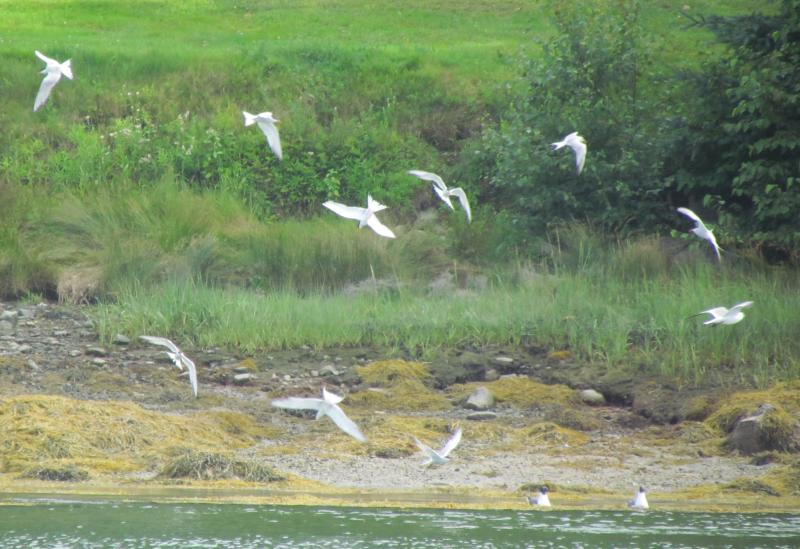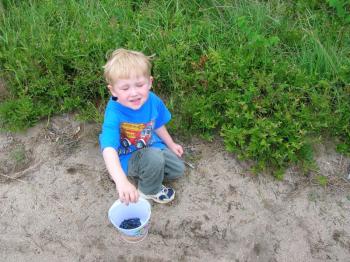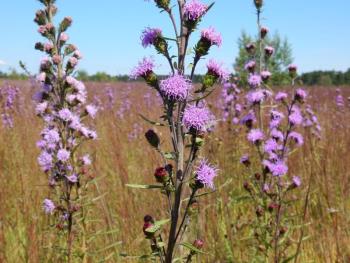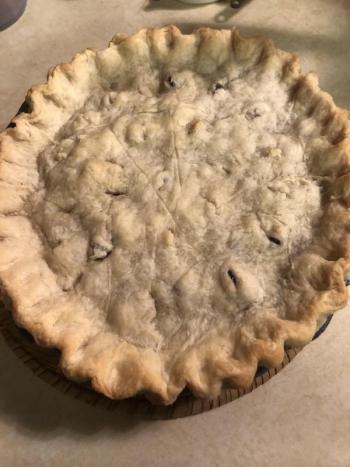Quiet Harbors, Roadside Blueberries, and Memorable Birds: August in Maine
The glorious blue-sky summer day on Sunday lured us to take a ride down to Pemaquid Harbor. The tide was near high when we arrived in the late afternoon, and the temperature still warm enough for kids (and a few adults) to be taking quick dips into the frigid salty water. People in brightly colored kayaks— yellows and oranges and blues—made their way back from an hour or two on the water. As they nosed their kayaks onto the gravel beach with a gentle crunching noise, we could hear them sharing stories about the things they had seen.
We scanned the harbor with our binoculars. There on a float a hundred yards away were a few dozen common terns. More patrolled the shallower edges near shore, searching for schools of small fish. Far, far away, in the back of the harbor, a flock of at least 50 of them wheeled around over the water, clearly working an abundance of the small fish they prefer. Every now and then, one of the terns would pass close by us, its black cap, gray back and wings with wedges of black near the wingtips evident with each deep wingbeat.
One of the terns came bounding by with a fish hanging from its black-tipped red bill. It turned and headed straight for the float where the others were sitting in the sun. We watched with the telescope as it neared the float. A young tern, clearly one hatched just this summer, began calling. It raised its wings and opened its bill as the adult swooped down to land face-to-face with its youngster. The young tern took the fish quickly and swallowed it down before any of the others had a chance to grab it away.
We scanned the group some more and watched as the same scene played out over and over with the 10 or so young terns enjoying the late-summer bounty of the sea.
On our drive home, we caught sight of another sign of the bounty of the season: Maine wild blueberries for sale at a roadside stand! We stopped and bought enough for a pie, plenty for cereal in the morning, and maybe even some left over to freeze for later.
Maine wild blueberries come from unique open habitats that most people today call blueberry barrens. These blueberry barrens often host specialized birds and other animals and plants.
Our thoughts turn to one Maine blueberry barren that holds a special place in our hearts: the Kennebunk Plains. The Plains, as it is called in the area, is home to birds found at few other places in Maine. These include breeding grasshopper sparrows, vesper sparrows, and upland sandpipers. It’s one of few places in the state with northern black racer snakes, and the fields turn purple with the flowers of the rare northern blazing star in late August and September.
At one time, the Kennebunk Plains was managed solely for commercial wild blueberry production. But a new herbicide began to be applied there in the early 1980s that killed all the other plants except the blueberries. This, of course, made it unsuitable for many of the species that called it home.
After many seasons documenting the dire changes in the habitat, initiated by the late Peter Vickery (and including years of research by Jeff, assisted at times by Allison), this land became one of the first recipients of Land for Maine’s Future funding, allowing it to be purchased to become a special place managed for the plants and animals (including birds) that make it so unique.
Today, anyone can visit the Kennebunk Plains. It is a state-owned Wildlife Management Area. In August, in certain spots on the Plains, the ground can seem to shimmer with the deep blue color of native lowbush blueberries, still growing in abundance here—a bounty enjoyed by birds, animals, and people.
Although our blueberries didn’t come from the Kennebunk Plains, they are a reminder of other beautiful Maine places. As we enjoy the berries’ distinctive sweet flavors, we’ll be thinking about those places and special birds in the blueberry barrens of Maine.
Jeffrey V. Wells, Ph.D., is a Fellow of the Cornell Lab of Ornithology and Vice President of Boreal Conservation for National Audubon. Dr. Wells is one of the nation's leading bird experts and conservation biologists. He is a coauthor of the seminal “Birds of Maine” book and author of the “Birder’s Conservation Handbook.” His grandfather, the late John Chase, was a columnist for the Boothbay Register for many years. Allison Childs Wells, formerly of the Cornell Lab of Ornithology, is a senior director at the Natural Resources Council of Maine, a nonprofit membership organization working statewide to protect the nature of Maine. Both are widely published natural history writers and are the authors of the popular books, “Maine’s Favorite Birds” (Tilbury House) and “Birds of Aruba, Bonaire, and Curaçao: A Site and Field Guide,” (Cornell University Press).































